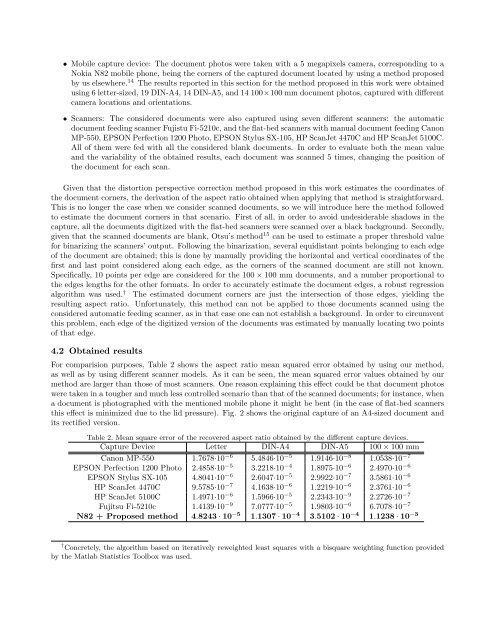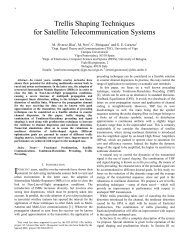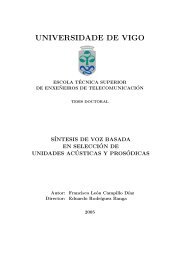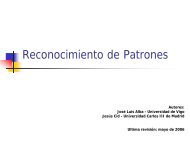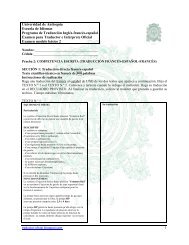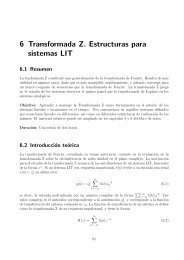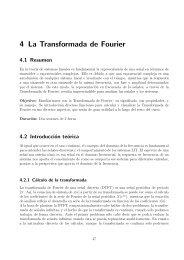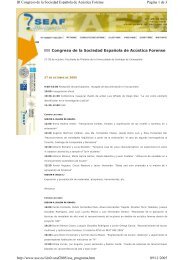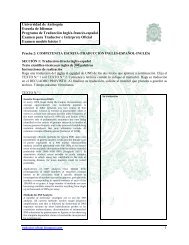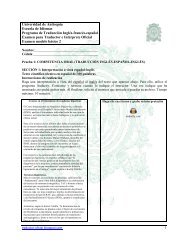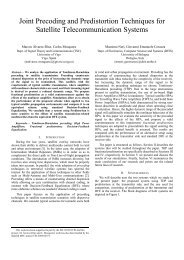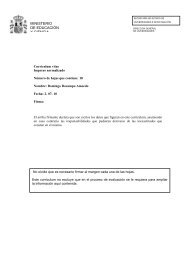A new method for perspective correction of document images
A new method for perspective correction of document images
A new method for perspective correction of document images
- No tags were found...
You also want an ePaper? Increase the reach of your titles
YUMPU automatically turns print PDFs into web optimized ePapers that Google loves.
• Mobile capture device: The <strong>document</strong> photos were taken with a 5 megapixels camera, corresponding to aNokia N82 mobile phone, being the corners <strong>of</strong> the captured <strong>document</strong> located by using a <strong>method</strong> proposedby us elsewhere. 14 The results reported in this section <strong>for</strong> the <strong>method</strong> proposed in this work were obtainedusing 6 letter-sized, 19 DIN-A4, 14 DIN-A5, and 14 100×100 mm <strong>document</strong> photos, captured with differentcamera locations and orientations.• Scanners: The considered <strong>document</strong>s were also captured using seven different scanners: the automatic<strong>document</strong> feeding scanner Fujistu Fi-5210c, and the flat-bed scanners with manual <strong>document</strong> feeding CanonMP-550, EPSON Perfection 1200 Photo, EPSON Stylus SX-105, HP ScanJet 4470C and HP ScanJet 5100C.All <strong>of</strong> them were fed with all the considered blank <strong>document</strong>s. In order to evaluate both the mean valueand the variability <strong>of</strong> the obtained results, each <strong>document</strong> was scanned 5 times, changing the position <strong>of</strong>the <strong>document</strong> <strong>for</strong> each scan.Given that the distortion <strong>perspective</strong> <strong>correction</strong> <strong>method</strong> proposed in this work estimates the coordinates <strong>of</strong>the <strong>document</strong> corners, the derivation <strong>of</strong> the aspect ratio obtained when applying that <strong>method</strong> is straight<strong>for</strong>ward.This is no longer the case when we consider scanned <strong>document</strong>s, so we will introduce here the <strong>method</strong> followedto estimate the <strong>document</strong> corners in that scenario. First <strong>of</strong> all, in order to avoid undesiderable shadows in thecapture, all the <strong>document</strong>s digitized with the flat-bed scanners were scanned over a black background. Secondly,given that the scanned <strong>document</strong>s are blank, Otsu’s <strong>method</strong> 15 can be used to estimate a proper threshold value<strong>for</strong> binarizing the scanners’ output. Following the binarization, several equidistant points belonging to each edge<strong>of</strong> the <strong>document</strong> are obtained; this is done by manually providing the horizontal and vertical coordinates <strong>of</strong> thefirst and last point considered along each edge, as the corners <strong>of</strong> the scanned <strong>document</strong> are still not known.Specifically, 10 points per edge are considered <strong>for</strong> the 100 × 100 mm <strong>document</strong>s, and a number proportional tothe edges lengths <strong>for</strong> the other <strong>for</strong>mats. In order to accurately estimate the <strong>document</strong> edges, a robust regressionalgorithm was used. † The estimated <strong>document</strong> corners are just the intersection <strong>of</strong> those edges, yielding theresulting aspect ratio. Un<strong>for</strong>tunately, this <strong>method</strong> can not be applied to those <strong>document</strong>s scanned using theconsidered automatic feeding scanner, as in that case one can not establish a background. In order to circumventthis problem, each edge <strong>of</strong> the digitized version <strong>of</strong> the <strong>document</strong>s was estimated by manually locating two points<strong>of</strong> that edge.4.2 Obtained resultsFor comparision purposes, Table 2 shows the aspect ratio mean squared error obtained by using our <strong>method</strong>,as well as by using different scanner models. As it can be seen, the mean squared error values obtained by our<strong>method</strong> are larger than those <strong>of</strong> most scanners. One reason explaining this effect could be that <strong>document</strong> photoswere taken in a tougher and much less controlled scenario than that <strong>of</strong> the scanned <strong>document</strong>s; <strong>for</strong> instance, whena <strong>document</strong> is photographed with the mentioned mobile phone it might be bent (in the case <strong>of</strong> flat-bed scannersthis effect is minimized due to the lid pressure). Fig. 2 shows the original capture <strong>of</strong> an A4-sized <strong>document</strong> andits rectified version.Table 2. Mean square error <strong>of</strong> the recovered aspect ratio obtained by the different capture devices.Capture Device Letter DIN-A4 DIN-A5 100 × 100 mmCanon MP-550 1.7678·10 −6 5.4846·10 −5 1.9146·10 −8 1.0538·10 −7EPSON Perfection 1200 Photo 2.4858·10 −5 3.2218·10 −4 1.8975·10 −6 2.4970·10 −6EPSON Stylus SX-105 4.8041·10 −6 2.6047·10 −5 2.9922·10 −7 3.5861·10 −6HP ScanJet 4470C 9.5785·10 −7 4.1638·10 −6 1.2219·10 −6 2.3761·10 −6HP ScanJet 5100C 1.4971·10 −6 1.5966·10 −5 2.2343·10 −9 2.2726·10 −7Fujitsu Fi-5210c 1.4139·10 −9 7.0777·10 −5 1.9803·10 −6 6.7078·10 −7N82 + Proposed <strong>method</strong> 4.8243 · 10 −5 1.1307 · 10 −4 3.5102 · 10 −4 1.1238 · 10 −3† Concretely, the algorithm based on iteratively reweighted least squares with a bisquare weighting function providedby the Matlab Statistics Toolbox was used.


